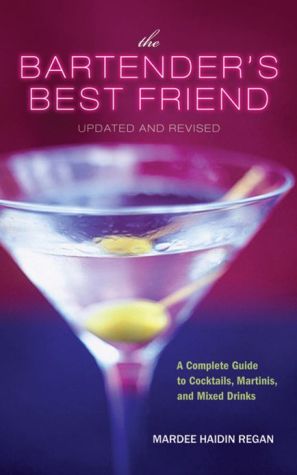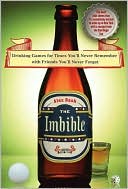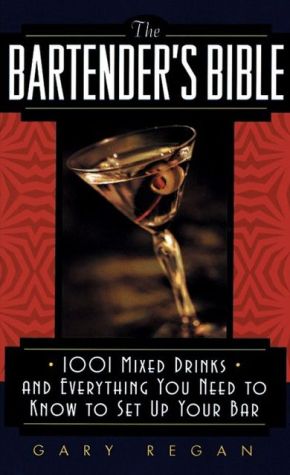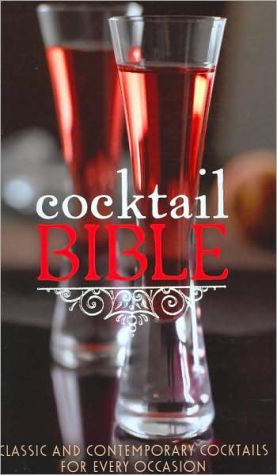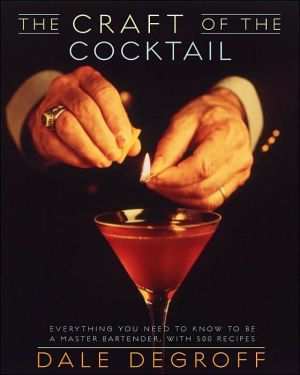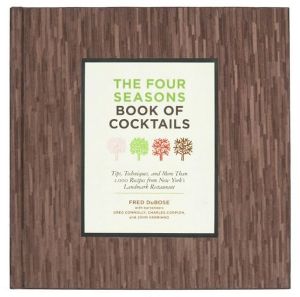The Bartender's Best Friend: A Complete Guide to Cocktails, Martinis, and Mixed Drinks
A newly revised second edition of the ultimate bartender's Bible\ This up-to-date, practical, and easy-to-use guide presents recipes for hundreds of cocktails and mixed drinks, plus step-by-step directions for making virtually every popular mixed drink, both contemporary and classic-from an A.B.C. to a Zorbatini. Plus, the book includes full coverage of all the basics of bartending, including equipment, ingredients, techniques, glassware, and garnishes.\ \ Includes more than 850 recipes in...
Search in google:
The ultimate bartender's guide! Up-to-date recipes, step-by-step instructions, and much, much more Bottoms up! The Bartender's Best Friend is the ultimate resource for professional bartenders and serious home mixologists. It's practical, totally up-to-date, and easy to use. Inside, you'll find hundreds of recipes for cocktails and mixed drinks, ranging from the latest creations to the favorites we all know. With everything from a classic Old-Fashioned to a contemporary Pomegranate Julep, it's all here! Plus, you'll find total coverage of the bartending basics—including equipment, ingredients, techniques, glassware, and garnishes.More than 850 recipes—including hundreds new to this editionClear, step-by-step instructions and problem-solving tipsHandy companion website for the latest drink innovationsWaterproof, wipe-dry cover with place-keeping ribbon for on-the-job useMini-course on professional bartending
Introduction: About This Book\ \ Cocktails are fashion--they bespeak the era of their creation. Cocktails are an expression of style, and like music, art, architecture, theater, and design, in many ways they reflect the attitude of the nation. Right now cocktail culture is soaring. No matter where you look--in magazines, newspapers, films, and on television--you see people drinking cocktails.\ Many of our favorite cocktails reflect our mindset. Some are based on classic combinations, some are casual and irreverent, often verging on downright silly, and many are the result of any number of incredible new ingredients in the marketplace. You couldn't get root-beer schnapps in the fifties.\ Cocktail trends are an aspect of pop culture. Although some drinks hearken to our childhoods, scores of others take their inspiration from foods, films, television, songs, books, and world events. One sizeable group of drinks are alcoholic concoctions that taste like something entirely different--a cookie or a candy bar. Another group of drinks requires a helper--it takes two to drink a Mouth Margarita. And then there are the drinks whose names are X-rated. Don't object. That's the way it is. And they sell like wildfire.\ Who is the bartender's best friend? The best tipper at the bar? Probably. But in writing this book, I've tried to be a friend to the bartender by including many cocktails and mixed drinks that are actually ordered at bars nationwide. When someone orders a Manhattan, you might not have to look in this book, but the recipe is here if you need it, and if somebody asks you to fix them a Schnapp, Crackle & Pop, and you're a little bewildered,just turn to "S" and you'll be serving one up in no time.\ On a more serious note, the bartender's very best friend can often be an experienced, sober driver or the local taxi service. Why? Because as enjoyable and fun as drinking and serving cocktails, wines, and beers can be, the unimpeachable fact is that alcohol affects our bodies and our minds, impairing our judgment and reaction time. Don't drink and drive, and don't let others drink and drive either. What's ultimately most fashionable is being alive to enjoy another day.\ Bartending Basics\ Making a cocktail has just four requirements. The first three are easy: You need ingredients--the spirits, the juices, the ice, the sodas, the garnishes. You need equipment--a shaker, a strainer, a spoon. And you need something to serve the drink in, be it the finest lead crystal cocktail glass or a paper cup. The fourth requirement, however, is the tough one. You need to understand how to use these elements, and, ideally, you must acquire a grasp of how they intermingle. And therein lies the rub: You can make drinks or you can master drink-making, the craft of bartending. The choice is yours; the basics are outlined here. Mastering the craft requires thought, effort, and just like getting to Carnegie Hall--practice, practice, practice.\ Equipment\ Tools and the methods of using them define the quality of the job performed. And just as a carpenter invests in his saws, a chef in his knives, or a painter in his brushes, a bartender needs to have the right stuff on hand to make the job easier and more professional. Once the proper tools are in place, you're good to go. Here's what's needed:\ \ Barspoon: An ingenious long-handled spoon that has an almost teardrop-shaped bowl and a twisted shaft that makes stirring with one hand very easy. Absolutely essential if you want to do it right.\ Bar towels: Two kinds--small, absorbent terrycloth towels that can be used as a bar mat to soak up spillage, splashes, and condensation; tightly woven, flat-weave cotton or linen dishtowels for polishing glasses or grasping wet, chilled wine bottles that are being held in a wine bucket. You'll need several of each.\ Blender: A heavy-duty machine capable of rendering ice cubes and other ingredients into slush. Can opt for the 32- or 48-ounce container; I prefer a metal to a plastic base. Essential for frozen drinks.\ \ Ingredients\ Spirits\ Distilled spirits have been with us since the 1100s when the art of distillation, which had been practiced for centuries at that point, was finally used to distill alcoholic products, such as wine. Initially, because spirits were liquids that could be set on fire, they were known as ardent spirits, from the Latin adere, meaning "to burn," but because they were first used as medicines, they became known as the water of life, and this name is still with us today. France produces eaux-de-vie; Scandinavia makes aquavit, and both of these terms translate to "water of life." Even the Gaelic word uisga beatha (Ireland) or usquebaugh (Scotland) which was anglicized to "whisk(e)y," means water of life. Here are some definitions for the main categories of distilled spirits, along with some explanations of various specific bottlings, and the most important distillation terms you should know.\ \ Absente: See Absinthe and Absinthe Substitutes.\ Absinthe and Absinthe Substitutes: Absinthe was outlawed in many countries during the first couple of decades of the twentieth century, and although its popularity waned, it has recently made a big comeback in countries where it wasn't banned--notably Andorra, the Czech Republic, England, Germany, Japan, and Spain. The reason that absinthe was banned was that it was said to be addictive and hallucinogenic because of one ingredient, wormwood, a bitter herb, that contains thujone, which has a molecular structure that's strikingly similar to THC, the active ingredient in marijuana. In all probability, though, it was the high alcohol content of absinthe--most bottlings verged on almost 70 percent alcohol by volume (abv)--that caused absinthe drinkers to act so strangely.\ In the United States, where absinthe was made illegal in 1915, we now use absinthe substitutes--Pernod, Ricard, Herbsaint, and Absente--when absinthe is called for in a drink. These spirits are often consumed after dilution with water, but in the case of Absente, it's best to add sugar, too.\ Amer Picon: Hard to find in the United States, this is a French apéritif wine with orange/herbal notes.\ American Brandy: Distilled from a fermented mash of grapes, American distillers have a huge advantage over many other brandymakers: the law does not proscribe which grape varieties can be used, and thus, they can employ whichever grape variety takes their fancy. The result is some truly great American brandies that are loaded with complexity, perhaps because they are made from top-notch grapes.\ Apple Brandy: Distilled from a fermented mash of apples, apple brandy is usually aged in oak barrels, sometimes for decades, but more usually for about three to five years.\ Applejack: A blended apple brandy used in many cocktails.\ Armagnac: A grape brandy made in the Gascony region of France, which is divided into three subregions: Ténarèze, Haut-Armagnac, and Bas-Armagnac. Armagnac must be made only from white grapes, Ugni Blanc (also known as Saint-Emilion), Colombard, and Folle Blanche varieties being the most common. Armagnac is usually aged in black oak casks, and the minimum age of the brandy is noted on the bottle using the same terminology as cognac.\ Bourbon: Distilled from a fermented mash that must contain a minimum of 51 percent corn, the other grains used are malted barley and either rye or wheat. Bourbon must be aged in new, charred oak barrels for a minimum of two years, though most bottlings have spent at least four years in the wood. The name, bourbon, comes from the Kentucky county from which whiskey from the area was shipped in the late 1700s. Bourbon can be made legally anywhere in the United States, although, with the exception of one Virginia distillery, at the time of writing it is all made in Kentucky. Bourbon is the only spirit that was born in the United States; all others originated elsewhere.\ Small-batch bourbon usually denotes whiskey that has been selected from a small quantity of barrels that has aged into what the distiller thinks is a whiskey that's superior to his regular bottlings. Keep in mind, though, that each distillery has its own criteria for using this term, and it has not been legally defined.\ \ The Home Bar\ A home bar can take whatever form suits its bartender or its location. When I was growing up, we had no bar--liquor was stored in a kitchen cabinet, wine was in the garage, and the manual ice crusher sat next to the grater and the measuring cups. Some of my friends' parents had incredible bars back then, though, usually in the basement rec room, often with a real wooden bar, tall bar stools or swivel chairs, and a back bar area to display the liquor bottles, mechanical toys, neon signs, and beer paraphernalia that were highly sought-after. Collectible decanters were all the rage, as were beer steins in a multitude of sizes, and Highball glasses emblazoned with pictures of pretty women--Vargas girls, usually--whose bathing suits disappeared when cold liquids were poured into the glass.\ If the bar area was located upstairs, it tended to be much fancier and more sophisticated. Really wonderful Art Deco or Danish Modern cocktail carts were outfitted to contain liquor decanters, tiny ice buckets, special glassware, and often some strikingly beautiful glass stirrers. Sometimes the living room had a wet bar in the corner; glass shelves displayed liquors--often in crystal decanters--and more often than not, a number of bottles of sweet liqueurs. One family I knew had a beer tap that jutted out from the stones of their floor-to-ceiling fireplace--now, that was cool.\ Today, though, your home bar is what you make it. If you have a collection of lovely cocktail accoutrements, show them off. If not, your homely collection of Boston shaker, barspoon, and Hawthorne strainer plus your ingredients simply need to be where you can find them at a moment's notice.\ The Cocktail Party Bar\ Some people are partygivers; others can't imagine throwing a party. Here's my thinking: For a dinner party, holiday meal, or special celebration where I will serve a meal, my limit is 12 for a sit-down and maybe up to 20 for a serve-yourself buffet or barbecue. On the other hand, one of the greatest hosts I ever met, the very stylish Lee Bailey, taught me a secret many moons ago: Have a cocktail party--all you need to serve is nuts. And that's just what he did--with great élan, mixed cocktail nuts in bail-handled shiny paint cans direct from the nut supplier--at the many parties I attended chez Bailey.\ Well, I'm a big copycat. That's just what I do, too. The best aspect of cocktail parties is that you can invite dozens--hundreds, even--of people, and though you'll run yourself ragged getting everything ready on party day, you'll be free to enjoy your guests, your cocktails, and the crowd.\ Now, don't get crazy about this party; you can limit its difficulty. Indeed, I hereby give you permission to be different: You do not have to have a full open bar . You can make it, say, a Cosmopolitan party--the only alcoholic drink served will be the Cosmopolitan. You could have a vodka party that features iced vodka, flavored vodkas, and no other liquor. You can have a punch party if you want to do absolutely everything ahead of time. In fact, making a tasty nonalcoholic punch that individual drinkers can spike for themselves is an excellent ploy for a get-together that can include children and adults.\ My best tips for large-scale partygiving are these:\ \ have large trash cans handy;\ have lots and lots of cocktail napkins around;\ don't run out of ice;\ serve nuts--or equally simple-to-put-out and replenish store-bought snacks;\ hire a bartender, if possible;\ don't let anyone overdo it;\ appoint designated drivers and have a taxi service number handy;\ pray for good weather.\
Introduction: About This Book1Bartending Basics2Equipment2Ingredients6Glassware34Basic Garnishes37Bartending Techniques38Drink-Making Techniques40The Home Bar46Stocking a Home Bar47The Cocktail Party Bar49Drinks A To Z51The Professional Bartender: How to Be the Best334A Bartender's Glossary342Bibliography349Index353
